 |
|

|
 |
TABLE of CONTENTS
 |
Major state highway projects wrap up as 2016 road construction season comes to an end |
By Rich Kemp

Crews provide the finishing touches on the Hwy 11 project in Baudette. Photo by David Gonzalez |
Motorists are starting to see the benefits of the 2016 road construction season as many of the state’s 246 construction projects wrap up for the season.
Some of the big projects completed this year include the Dresbach Bridge in southeastern Minnesota; Interstate 494, I-35E, Hwy 100 and Hwy 610 in the Twin Cities Metro area; I-94 in central Minnesota; and the I-94 interchange at Hwy 75 in Moorhead.
“We completed some very significant projects this year,” said Commissioner Charlie Zelle. “It was important work that improved safety and ensured that the transportation system will continue to support the state’s economic progress.”
Statewide project highlights for 2016 include:
Twin Cities area
- St. Croix Crossing (Hwy 36) – All river pier construction was completed this construction season, and the final segments on the river bridge and approach bridge were placed in October. The bridge is scheduled to open to traffic in fall 2017.
- I-35E in St. Paul – This four-year project is nearing completion as traffic shifted to the permanent I-35 lanes between I-94 and Maryland Avenue. The Cayuga interchange will be complete when the ramp from southbound I-35E to Cayuga St. is opened around Thanksgiving. Final stages of project will be completed in spring 2017.
- I-494 rehabilitation between I-394 and the I-94/I-494/I-694 interchange – Crews are finishing construction on northbound I-494 between the I-94/I-494/I-694 interchange and I-394. Both directions of I-494 between I-394 and Hwy 55 will open to three lanes of traffic in early November. The three-year project added a lane in each direction, replaced bridges and did maintenance repairs on several ramps.
- Hwy 610 in Maple Grove – The newest stretch of highway in the Twin Cities Metro area should open to traffic just before Thanksgiving. The 2.5 mile extension of Hwy 610 will carry traffic between the Hennepin County Road 81 and Elm Creek Boulevard area and I-94 in Maple Grove.
- Hwy 100 - The Hwy 7 bridge over Hwy 100 in St. Louis Park reopened Oct. 31. Hwy 100 between 36th Street and 25½ Street will remain two lanes in each direction until the second week of November while crews continue working on the center median barriers. The 2.5 year construction project included widening the highway to include three lanes in each direction, reconfiguring and reconstructing the Minnetonka Boulevard, the Hwy 7 and the Cedar Lake Trail/railroad bridges and building noise walls along the 1.6 mile stretch of road.
- I-35E between Vadnais Heights and White Bear Lake - The majority of the work will be

During July, water was disbursed to hold down the dust on the Hwy 100 construction project. The highway was widened to three lanes in each direction. Photo by David Gonzalez |
complete in late November. The project included resurfacing the roadway and ramps, replacing or re-decking bridges and adding MnPASS lanes and noise walls. The Hwy 96 bridge over I-35E is expected to open in mid-November. The MnPASS lanes and the two I-35E bridges over Goose Lake Road will be completed by late November.
- I-694 – The first year of work to add a third lane to each direction of I-694 between Rice Street in Little Canada/Vadnais Heights and Lexington Avenue in Arden Hills is nearly complete. The new westbound lane will be completed by late November with three lanes of traffic and no restrictions through the winter. Construction of the new third lane on the eastbound roadway in the same area begins next year.
- Hwy 5 in St. Paul near Fort Snelling – The Hwy 5 bridge and trail are complete and open. Crews also repaired the Shepard Road and Edgcumbe Road bridges.
- Hwy 61 and Hwy 97 roundabouts in Forest Lake — Crews reconstructed the Hwy 61 and Hwy 97 intersections in Forest Lake, removed the traffic signals from the north and south intersections of Hwy 97 and replaced them with two roundabouts to enhance traffic flow in the area.
- Hwy 36 in Roseville – Construction of two new bridges to carry Hwy 36 over Lexington Avenue was completed early this fall. Resurfacing of the highway between Dale Street and Hamline Avenue, and work on the ramps at Hamline Avenue and Dale Street, will be completed by early November.
- I-94 bridges in St. Paul - Crews repaired nine bridges at Pelham Avenue, Cretin Avenue, Cleveland Avenue, Prior Avenue, Pascal Street, Hamline Avenue, Lexington Avenue, Victoria Street and Dale Street. Work included concrete repair, patching, resurfacing, guardrail upgrades, bridge rail upgrades, accessible pedestrian ramp improvements, bridge inspections and a bridge re-deck on the Prior Avenue bridge.
Northern Minnesota
- Hwy 53 relocation project - Crews continue to install the large steel girders that will support the roadway and pedestrian walkway on the bridge over Rouchleau Pit. Crews will continue to place beams through January, 2017 and will begin the bridge deck construction next spring. The new roadway and bridge will open in November 2017.
- I-35 Pine County resurfacing and bridge replacement – The effect to motorists was reduced on this project by completing it in one construction season instead of two. This project included pavement resurfacing, new guardrail, new approach panels and a new bridge.
- Hwy 217 resurfacing and bridge repair project – This project, south of International Falls, repaired the Hwy 217 bridge at the Rat Root River and resurfaced 17 miles of highway.
- I-94/Hwy 75 in Moorhead – Work on I-94 and the I-94/Hwy 75 interchange in Moorhead wrapped up in late October. The project included constructing auxiliary lanes on I-94 and reconstructing the I-94/Hwy 75 interchange to a diverging diamond configuration.
- Hwy 75 near Kent – Work on the Hwy 75 realignment project near Kent is nearly complete. The new alignment removes the road from the flood plain and eliminated a low-clearance railroad bridge.
- Hwy 11 in Baudette - This project was finished 17 days ahead of schedule. It resulted in the modernization of city utilities, improved drainage, enhanced pedestrian safety and extended the life of the Hwy 11 pavement and Baudette Bay Bridge deck.
Central Minnesota
-
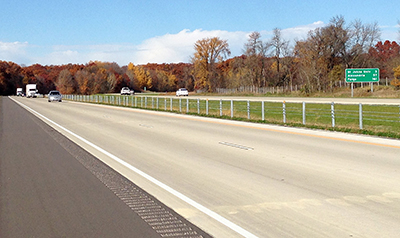
The I-94 project between St. Cloud and Collegeville resurfaced six miles of the interstate and repaired two bridges. Photo by Tim Paul |
Hwy 371 four-lane expansion – Project expands Hwy 371 to four lanes from Nisswa to Jenkins and is scheduled to open May/June 2017. Project will be complete by fall 2017.
- I-94 St. Cloud to Collegeville – Resurfaced six miles of I-94 between St. Cloud and Collegeville,
and repaired two bridges at the I-94/Hwy 15 interchange in St. Cloud.
- Hwy 25 in Buffalo – A project to reconstruct much of Hwy 25 through Buffalo’s downtown business district will be complete this fall. The project reconstructed the road, improved the Hwy 25/Hwy 55 intersection, improved utilities, upgraded lighting, will expand a segment of Hwy 25 to four lanes.
Western Minnesota
- I-94/Hwy 29 in Alexandria – Crews are nearing completion on a two-year bridge, four-lane expansion and roundabout project near I-94. This year’s work involved reconstructing the Hwy 29 bridges over I-94, along with signal and lighting upgrades and interstate ramp improvements.
- Hwy 23 from I-90 to Willmar – Crews constructed passing lanes along the Hwy 23 corridor, creating passing opportunities to provide the most benefit to manufacturers, commuters, agricultures and others that use the highway.
Southern Minnesota
- Dresbach Bridge (I-90) – The new Mississippi River crossing has traffic traveling on two separate bridges parallel and upstream from where the previous bridge stood. The new interchange provides full movement with no signals between I-90 and Hwy 61, and access to the Minnesota Welcome Center and boat launches from all directions.
- Winona Bridge (Hwy 43) – Construction was completed on the new bridge, which opened to traffic in August. The existing bridge is closed and workers have begun the rehabilitation work, which is expected to be completed sometime in the fall 2019 to spring 2020.
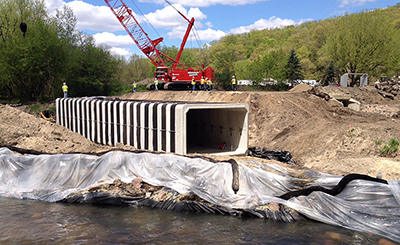
Crews install a culvert at the 7 Mile Creek Park area along Hwy 169. Photo courtesy of District 7 |
- Hwy 169 Mankato to St. Peter – Hwy 169 was resurfaced and raised in four flood-prone areas. Median barriers were added to reduce cross-over crashes. This was the third and final flood mitigation project along the Minnesota River in south central Minnesota.
- Hwy 14 Nicollet to North Mankato – The project to expand Hwy 14 to four lanes and build a south bypass of Nicollet with an interchange for Hwy 14/Hwy 111 will be completed in November.
- I-90 preservation projects – Multiple projects to preserve the aging interstate in southwest Minnesota took place in 2016. This effort to restore I-90 began in 2014 and will continue into 2018.
For a complete list of 2016 projects and their status, see www.mndot.gov/roadwork/current.html; and for studies and plans for possible future projects, visit www.mndot.gov/roadwork/future.html. |
 |
|

|
 |
TABLE of CONTENTS
 |
MnDOT, other state agencies to share unified state logo design |

MnDOT will adapt the new state branding initiated by the Governor's Office in mid-December. |
If you’ve browsed Minnesota state agency websites lately, you’ll notice something has changed: many of them have new logos that sport a similar look.
Within a few weeks, MnDOT, too, will begin the transition to the new state branding that the Governor’s Office initiated to increase recognition for state agencies, build trust and help create a sense that government works together to make life better for all Minnesotans.
MnDOT is part of the first phase of state agencies to make the change to the new design. By summer 2017, all state agencies will have adopted the unified brand. Other agencies in the first phase include the departments of Administration, Employment and Economic Development, Human Services, Management and Budget, MN.IT Services, Natural Resources, Revenue and the Office of Higher Education.
Why are we making the change?
This video, created by MN.IT, illustrates why a unified brand is an important move for the state of Minnesota. While Minnesotans are familiar with the largest corporations and educational institutions in our state, they are unaware and often confused by the multitude of logos affiliated with state agencies.
Timeline
By mid-December 2016, you will begin seeing MnDOT’s new logo on our external and internal websites, social media platforms and all other electronic places where the current logo now resides. The Office of Communications will provide new templates for the various documents MnDOT staff use every day, including letterhead, memos, reports and PowerPoint presentations. The office also will establish agency guidance on logo use and how it relates to branding in general.
Over time, we will change the logo on more tangible things, such as MnDOT vehicles, truck stations, district headquarters and other agency facilities that now display the round logo. You will see it change eventually on our hard hats and vests, as well as on pins, business cards and identification cards.
What do you need to do?
For now, nothing. However, you should hold off ordering promotional and other items until the new logo is available. Contact Adam Peterson Oie, 651-366-4273, if you have questions about this.
In mid-December the Office of Communications will share information about how to access updated templates, email signatures and other materials. In addition to including the new logo, these templates will be fully accessible and ADA compliant.
“The transition will take some time. The intent is to make changes when it makes the most sense and is most cost efficient,” said Kevin Gutknecht, Communications director. “We will keep employees updated as the transition progresses.”
Visit iHUB for ongoing updates on MnDOT’s transition to the new logo. |
 |
|

|
 |
TABLE of CONTENTS
 |
Open Enrollment continues through Nov. 8 |
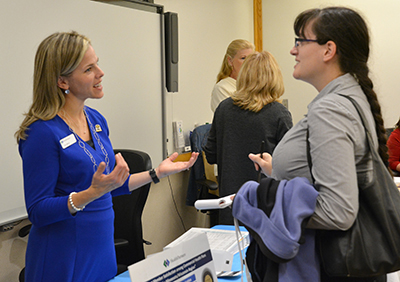
A representative from Health Partners explains benefits of using their services during an Open Enrollment meeting at Central Office Oct. 13. Photo by Libby Schultz |
Open Enrollment for 2017 benefits began Oct. 26 and will close at 11:59 p.m. on Nov. 8, 2016. Elections cannot be made or changed after this date.
Employees can change their medical insurance carriers and add/drop dependent or family coverage. The IRS announced the maximum Medical/Dental Expense Account for 2017 has increased to $2,600. Employees can now elect the higher limit through the Employee Self-Service system.
If you have any questions contact SEGIP by email at segip.mmb@state.mn.us or by phone at 651-355-0100 or 855-664-3597 (greater Minnesota). Central Office staff may also contact Deborah Schifsky at 651-366-3405; Pam Horwath at 651-366-3376; or Connie Eystad at 651-366-3398. District employees may contact their district human resources offices.
Where to Enroll (from Oct. 26 – Nov. 8, 2016):
Elections are submitted via the Employee Self-Service System:
www.state.mn.us/employee
Electronic Resources are available on the SEGIP website located:
mn.gov/mmb/segip/open-enrollment/ |
 |
|

|
 |
TABLE of CONTENTS
 |
WIG 2.0 Focus Area Highlight: Contracting goals to advance equity in the agency |
By Judy Jacobs
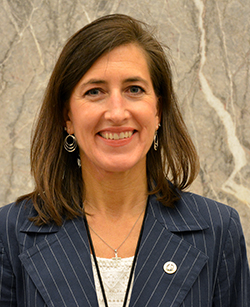
Nancy Daubenberger serves as champion for the WIG 2.0 Advancing Equity priority in the contracting focus area. Photo by Rich Kemp |
MnDOT employees across the state have been working on WIG 2.0 for almost two months. In that time, WIG teams have created more than 500 sub-WIGS designed to meet the ultimate goal of Earning Customer Trust through a customer-centered organization.
Advancing equity is, and has always been, a top priority of Gov. Mark Dayton’s administration. Executive Order 16‐01 directs Minnesota state agencies to identify and adopt best practices in equal employment opportunities, equal contracting opportunities and full participation in civic life for all Minnesotans.
Nancy Daubenberger, Engineering Services assistant commissioner, serves as champion for the WIG 2.0 Advancing Equity priority in the contracting focus area. This focus area promotes equal contracting opportunities as part of the overall WIG.
“We will identify and establish best practices to achieve equity in state procurement and contracting,” said Daubenberger. “This not only includes increasing opportunities to effectively do business with the state’s Disadvantaged Business Enterprises, Targeted Group Businesses and Military Veteran-owned businesses as subcontractors, but also as successful prime contractors with the state. In addition, we will continue to assist our more established prime contractors in building and retaining a more diverse contractor workforce representative of the communities in which they work.”
“Diversity and inclusion are core values at MnDOT,” said Daubenberger. “MnDOT is committed to expanding its intercultural competence and diversifying its workforce at all levels. However, disparities in employment and contracting still exist in the areas of Disadvantaged Businesses Enterprises, Targeted Group Businesses and Veteran-owned businesses.”
How can your team get involved?
To date, 29 WIG teams have recorded sub-WIGs focusing on the area of Advancing Equity in Contracting. Many of these teams are looking at ways to identify barriers that small business owners may face when they look to MnDOT for contracting their services. They are also exploring contractor training needs and working to understand how some of MnDOT's program requirements might adversely affect full inclusion.
Here are two Contracting sub-WIGs that may inspire your team:
- In the Engineering Services Division, the Office of Environmental Stewardship is working to increase the number of TGB and Veteran-owned consultants and landscape contractors who support environmental products and services from the current number of 17 to 27, and to increase contracts with TGB and Veteran-owned businesses supporting environmental products and services by June 30, 2018.
OES team WIG 2.0 coaches Summer Allen-Murley, transportation program specialist 4, and Carol Zoff, senior landscape architect, are proud of their teams’ effort to move the needle on Advancing Equity through contracting goals.
“When the WIG 2.0 framework was first announced, OES aimed to work on both priorities, but we were not sure we had the ability to achieve meaningful impacts to advance equity,” said Zoff. “The WIG 2.0 development assignment results helped distill our opportunities.”
“We realized OES-related contracting and consultant work was more often state-funded, so TGB and Veteran business goal outcomes were something we could try to help move the needle on,” said Allen-Murley. “We are keeping people engaged by learning about the TGB and Veteran business goal program, deepening everyone’s understanding of OES programs, and learning about business perspectives.”
- In the Modal Planning and Performance Measurement Division, the Office of Transportation System Management plans to double the number of registered DBEs in Ramsey County from its current three to six by June 30, 2017.
Daubenberger said teams are encouraged to think creatively about how they can make a positive difference for underrepresented groups.
“Although we have a long road ahead of us in advancing equity, every step we take in the right direction will help us close the equity gap,” said Daubenberger. “Our champions and teams are digging in to get a better understanding of what barriers are out there that create this gap, finding ways to remove them, and being intentional in providing opportunities.” |
 |
|

|
 |
TABLE of CONTENTS
 |
On the Job: Kristen Zschomler works to understand and preserve the past |
|
By Judy Jacobs

Kristen Zschomler stands on the newly renovated Franklin Avenue bridge in Minneapolis. Photo courtesy of Britta Greene, KFAI radio |
When Kristen Zschomler began her career with MnDOT almost 14 years ago, little did she know that one day she’d be tasked to research Prince’s boyhood home to determine if it is considered historically significant.
A typical day finds Zschomler researching properties, working to rehabilitate historic bridges and other iconic structures and partnering with various agencies to complete the historic review process for many projects.
Zschomler career’s path has taken her through a variety of positions within the department. She began her career at MnDOT as a project manager in the Cultural Resources Unit, and then became Unit Supervisor in 2013.
“I was also fortunate enough to do two mobilities,” Zschomler said. “One with the Office of Government Affairs and one in the Metro District as an area engineer--even though I am not an engineer!”
Zschomler’s job has her working closely with a wide variety of partners including MnDOT districts, State Aid, local agencies, the State Historic Preservation Office, Federal Highway Administration, Federal Transit Authority, Federal Rail Authority, the Corps of Engineers, tribal governments, as well as preservation and community groups.
“The historic review process is based on consultation and input from others, so we get the opportunity to work closely with many groups,” said Zschomler.
The most interesting aspect of her job is the variety of property types that she get to research or preserve. Recently, she had the opportunity to research Prince's childhood home. After his death, it was reported that his childhood house was on Newton Avenue North in north Minneapolis, which placed it within one of CRU’s project study areas. CRU staff needed to study it to see if it was historically significant for its association with him. Through researching city directories, property deed records, and even a fortunate encounter with the son of the people who sold the Newton House to Prince’s father, they found that while he did live at that house briefly as a teenager, his actual childhood home was on 8th Avenue North, also within the study area of the Bottineau Transit Line.
In an effort to try to get the results of the research out to his legion of fans coming in for the tribute concert and tours of his Paisley Park studio, Minnesota Public Radio station, The Current, published an article with information Zschomler provided. Zschomler will also be hosting a webinar about the research for the Wisconsin Historical Society in December.
“Being able to research where Prince grew up, to helping oversee the restoration of the Pierre Bottineau House or the Franklin Avenue Bridge, to working with District 1 to preserve remnants of the Grand Portage of the St. Louis River. I feel very lucky to have such an interesting job to go to every day,” Zschomler said.
What are you working on now?
Most of the projects I work on are rehabilitations of historic bridges. Right now, I am working on the Winona Bridge, the Stillwater Lift Bridge, the 3rd Avenue Bridge, and the Stewart River Bridge. This year, a few key projects were completed, including the Old Cedar Avenue Bridge and the Franklin Avenue Bridge restorations. It is wonderful to see these beautiful, iconic structures restored to their original appearance, and for future generations to be able to enjoy them. I am also wrapping up a three-phase project with the State Aid Office on developing management plans on locally owned historic bridges. The project resulted in a greatly improved historic bridge website, which provides the results of the studies, and provides valuable information on each historic bridge in the state.
How has your job changed since you started with MnDOT?
I would say the best change that I have experienced during my time at MnDOT is the collaborative work our unit now does with the Bridge Office, the State Aid office and the Districts on historic bridge projects. Through our historic bridge program, we have developed a collaborative process that allows us to work more closely from the beginning of a project, and to find solutions and common goals early on. It is through this partnership that we have been able to rehabilitate over 50 historic bridges in the past 10 years, on both the state and local system. Amber Blanchard, Bridge Office planning and hydraulics engineer, and I have also been able to take our experiences in Minnesota and share them with other DOTs by offering training on our historic bridge process in Oklahoma, Maine, Virginia, Texas and Oregon.
What’s the most important aspect of your job?
The most important aspect of my job is maintaining relationships with many parties, both internal and external to MnDOT. Specifically, I see my role as ensuring that the historic process is being followed accurately, while making sure that we are not doing more than the laws require.
What did you do before working at MnDOT?
I worked as an archaeologist and historian for various consulting firms and research institutes, doing work throughout the Midwest, Southeast, Caribbean and Mexico.
What do you enjoy most about your job?
The best part of my job is working with my amazing staff. They are consummate professionals, all with unique knowledge and talents. I am honored every day to get to work with them.
Do you or a co-worker have an interesting job to share with readers? Send us your ideas, and we’ll contact you for more information.
Recent employee profiles:
|
 |
|

|
 |
TABLE of CONTENTS
 |
ITS Minnesota recognizes Doug Lau for Intelligent Roadway Information System |
By Mary McFarland Brooks
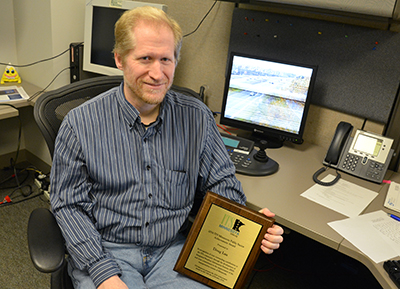
Doug Lau, RTMC, received Minnesota ITS 2016 award for work on IRIS. Photo by Mary McFarland Brooks |
Doug Lau, information technology specialist 4, recently received the 2016 Minnesota Intelligent Transportation Systems award for public employees for developing the software that supports MnDOT’s Intelligent Roadway Information System. IRIS is used throughout the state and by California, Nebraska and Wyoming.
Terry Haukom, Regional Transportation Management Center transportation program supervisor, nominated Lau for the honor, which was awarded last month at the ITS Minnesota Fall Forum at the University of Minnesota.
“Doug seems to have traffic in his blood, being the son of Rich Lau who was one of the pioneers of the Traffic Management System here in the Twin Cities. I am always amazed at the skill and ingenuity which Doug brings to the development of the software systems that help manage traffic,” said Terry Haukom.
IRIS became active in 1999 and has changed over the years to become more responsive and to integrate manipulation of various traffic controls. Lau said in the future there may be opportunities for reversible lane coordination using IRIS. Currently, the system can restrict roadways historically affected by blowing snow and ice in Greater Minnesota, by remotely operating gates to open and close highways.
MnDOT employees have received the ITS public sector award in eight of the last 10 years. Past MnDOT winners include Jim Kranig, Brian Kary and Kelly Braunig (jointly); Ray Starr, Sue Sheehan, Nick Thompson, Terry Haukom and Bernie Arsenau.
More information about ITS Minnesota is available at www.itsmn.org/. |
 |
|

|
 |
TABLE of CONTENTS
 |
Employees have opportunity to help others through Combined Charities campaign |
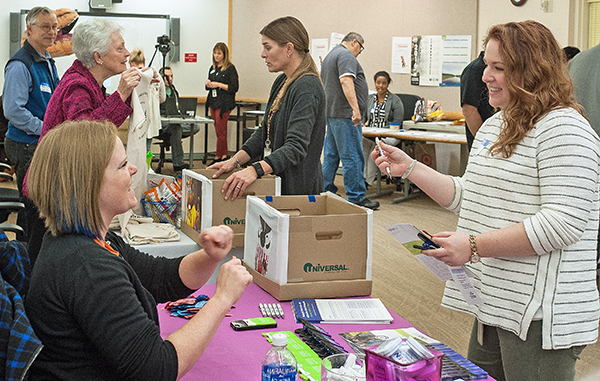
Wendy Surprise, Office of Chief Counsel (center), and Libby Schultz, Office of Communications. received information from different charity groups during an open house at Central Office Oct. 31 for the Combined Charities campaign. This year's campaign is being extended through Nov. 15 in an effort to help the campaign and agencies reach their goals. Visit the Combined Charities website to learn more about the campaign. Photo by David Gonzalez |
|
 |
|
| |
|



